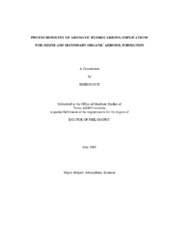The full text of this item is not available at this time because the student has placed this item under an embargo for a period of time. The Libraries are not authorized to provide a copy of this work during the embargo period, even for Texas A&M users with NetID.
Photochemistry of aromatic hydrocarbons: implications for ozone and secondary organic aerosol formation
Abstract
Aromatic hydrocarbons constitute an important fraction (~20%) of total volatile
organic compounds (VOCs) in the urban atmosphere. A better understanding of the
aromatic oxidation and its association in urban and regional ozone and organic aerosol
formation is essential to assess the urban air pollution.
This dissertation consists of two parts: (1) theoretical investigation of the
toluene oxidation initiated by OH radical using quantum chemical and kinetic
calculations to understand the mechanism of O3 and SOA precursors and (2)
experimental investigation of atmospheric new particle formation from aromatic acids.
Density functional theory (DFT) and ab initio multiconfigurational calculations have
been performed to investigate the OH-toluene reaction. The branching ratios of OH
addition to ortho, para, meta, and ipso positions are predicted to be 0.52, 0.34, 0.11,
and 0.03, respectively, significantly different from a recent theoretical study of the
same reaction system. Aromatic peroxy radicals arising from initial OH and
subsequent O2 additions to the toluene ring are shown to cyclize to form bicyclic
radicals rather than undergoing reaction with NO under atmospheric conditions.Isomerization of bicyclic radicals to more stable epoxide radicals possesses
significantly higher barriers and hence has slower rates than O2 addition to form
bicyclic peroxy radicals. At each OH attachment site, only one isomeric pathway via
the bicyclic peroxy radical is accessible to lead to ring cleavage. Decomposition of the
bicyclic alkoxy radicals leads primarily to formation of glyoxal and methyl glyoxal
along with other dicarbonyl compounds.
Atmospheric aerosols often contain a considerable fraction of organic matter,
but the role of organic compounds in new nanometer-sized particle formation is highly
uncertain. Laboratory experiments show that nucleation of sulfuric acid is considerably
enhanced in the presence of aromatic acids. Theoretical calculations identify the
formation of an unusually stable aromatic acid-sulfuric acid complex, which likely
leads to a reduced nucleation barrier. The results imply that the interaction between
organic and sulfuric acids promotes efficient formation of organic and sulfate aerosols
in the polluted atmosphere because of emissions from burning of fossil fuels, which
strongly impact human health and global climate.
Subject
molecular compositionaerosol formation
troposphere
nucleation
photooxidation
aromatic
toluene
vapors
phase
water
ab initio
theoretical
Citation
Suh, Inseon (2003). Photochemistry of aromatic hydrocarbons: implications for ozone and secondary organic aerosol formation. Doctoral dissertation, Texas A&M University. Texas A&M University. Available electronically from https : / /hdl .handle .net /1969 .1 /3893.


